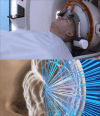Emerging clinical applications of high-intensity focused ultrasound
- PMID: 31287428
- PMCID: PMC6727814
- DOI: 10.5152/dir.2019.18556
Emerging clinical applications of high-intensity focused ultrasound
Abstract
High-intensity focused ultrasound (HIFU) is a minimally-invasive and non-ionizing promising technology and has been assessed for its role in the treatment of not only primary tumors but also metastatic lesions under the guidance of ultrasound or magnetic resonance imaging. Its performance is notably effective in neurologic, genitourinary, hepato-pancreato-biliary, musculoskeletal, oncologic, and other miscellaneous applications. In this article, we reviewed the emerging technology of HIFU and its clinical applications.
Conflict of interest statement
The authors declared no conflicts of interest.
Figures














References
-
- Wood RW, Loomis AL. The physical and biological effects of high frequency sound-waves of great intensity. Phil Mag. 1927;4:7–14. doi: 10.1080/14786440908564348. - DOI
Publication types
MeSH terms
LinkOut - more resources
Full Text Sources

